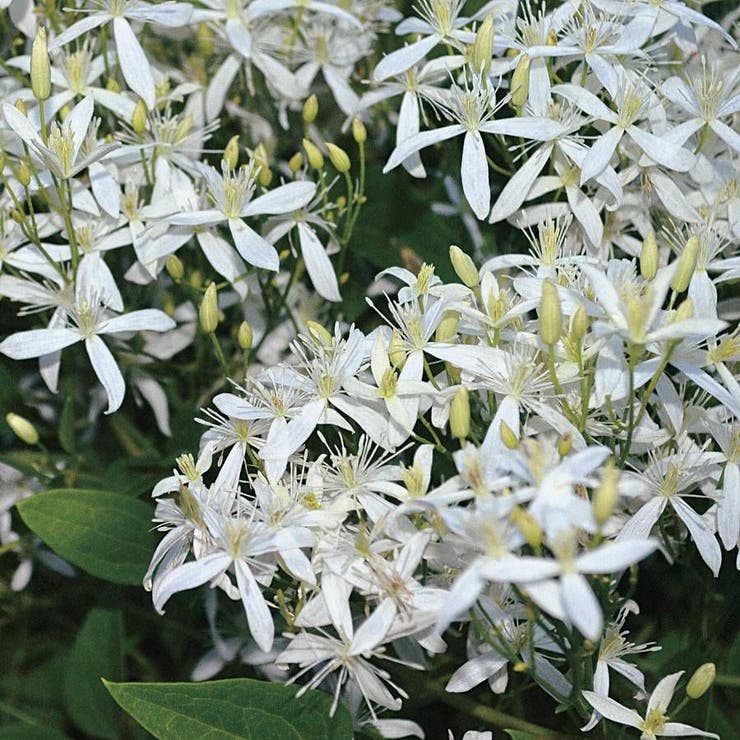
Dharaseeds
Clematis Sweet Autumn Seeds
Estimated Free Delivery between April 16 and April 19.
Secured Payment Methods
Your transaction is protected with advanced security measures to keep your information confidential
Clematis Sweet Autumn is a stunning, vigorous vine known for its profusion of small, fragrant white flowers that bloom late in the season. This variety is particularly valued for its ability to cover fences, trellises, and arbors with an abundance of blooms, often just when other plants are winding down for the year. Sweet Autumn Clematis is a hardy climber that thrives in various climates, offering a delightful display of color and fragrance, making it a must-have for gardeners seeking an easy-to-grow and low-maintenance flowering vine.
Key Benefits
- Abundant, Fragrant Blooms: Sweet Autumn produces a stunning display of small, star-shaped white flowers in late summer to fall, filling the garden with a sweet, honey-like fragrance.
- Fast-Growing: This clematis variety is known for its vigorous growth, quickly covering trellises, fences, and other vertical structures.
- Hardy and Resilient: Sweet Autumn is a hardy vine that can tolerate a range of growing conditions, thriving in both warm and cooler climates.
- Low Maintenance: Requires minimal care once established, making it an excellent choice for gardeners of all experience levels.
- Attracts Pollinators: The fragrant flowers attract bees, butterflies, and other beneficial pollinators, enhancing your garden’s ecosystem.
Variety Features
- Plant Characteristics: Clematis Sweet Autumn is a deciduous climbing vine that can grow up to 20–30 feet tall. It produces an abundance of white, fragrant flowers in late summer to fall.
- Flower Size: The flowers are small, measuring around 1–2 inches across, but they bloom in dense clusters, creating a striking effect.
- Growth Habit: This clematis is a vigorous climber that works well on fences, trellises, and arbors, often covering a large area quickly.
- Flowering Period: Sweet Autumn blooms profusely from late summer into fall, providing seasonal interest when many other plants are finishing their blooms.
Planting Instructions
Planting Season
- Plant Clematis Sweet Autumn Seeds in early spring after the last frost, or start them indoors about 6–8 weeks before the last frost date.
Planting Details
- Seed Depth: Plant seeds about 1/4 inch deep in well-draining soil or seed-starting mix.
- Spacing: Space plants 12–18 inches apart to allow for proper growth and airflow.
- Soil Requirements: Prefers well-draining, fertile soil with a neutral to slightly acidic pH (6.0–7.0).
- Sunlight: Requires full sun to partial shade, with at least 6 hours of direct sunlight daily to promote abundant blooms.
Care Instructions
Watering
- Keep the soil consistently moist but not waterlogged, especially during the first few years of growth. Once established, Sweet Autumn Clematis is fairly drought-tolerant but will still perform best with regular watering.
- Water at the base to avoid wetting the foliage, which can promote fungal diseases.
Fertilization
- Apply a balanced fertilizer (e.g., 10-10-10) in early spring to encourage healthy growth and strong flowering.
- Avoid excess nitrogen, as this can lead to excessive leafy growth at the expense of flowers.
Weeding and Mulching
- Keep the area around the base of the vine free from weeds, as they can compete for nutrients and water.
- Mulch around the roots to retain moisture, keep the soil cool, and suppress weeds. Be careful not to cover the plant’s crown with mulch.
Pruning
- Clematis Sweet Autumn blooms on new wood, so it should be pruned in early spring before new growth begins. Cut back dead or damaged stems and reduce the plant to about 12 inches to promote vigorous new growth.
- Light pruning after flowering can also help control its spread, as this variety is very vigorous.
Pest and Disease Control
Pests
- Common pests include aphids, spider mites, and snails. Use organic pest control methods like insecticidal soap or neem oil to manage these issues.
- Clematis can also attract clematis weevil, so monitor for damage to leaves and stems, particularly in early spring.
Diseases
- Clematis wilt is a potential problem for this variety. To prevent it, ensure proper spacing for airflow and prune away any infected stems immediately.
- Watch for powdery mildew, particularly in humid climates, and improve airflow by thinning dense growth and avoiding overhead watering.
Harvesting
Maturity
- Clematis Sweet Autumn reaches maturity in about 2–3 years, and it begins blooming in its second year, though it may take longer to establish from seed.
Harvesting Blooms
- The flowers are best enjoyed in the garden as they are not typically cut for arrangements. However, if desired, they can be harvested early in the bloom cycle and placed in water to extend their longevity.
Storage
Short-Term
- Cut flowers can be kept in water for a few days, but they are primarily ornamental and best enjoyed fresh on the vine.
Long-Term
- Seeds can be collected and stored in a cool, dry place for future planting. Ensure the seeds are fully dry before storing to prevent mold growth.
Culinary Uses
- Non-Edible: Clematis Sweet Autumn is grown primarily for its beauty and fragrance rather than for culinary purposes. It is valued as an ornamental plant in gardens and landscapes.
Conclusion
Clematis Sweet Autumn Seeds offer an outstanding option for gardeners looking to add a late-season burst of color and fragrance. With its vigorous growth, fragrant white flowers, and low maintenance needs, it’s perfect for trellises, fences, and arbors, where it can climb and bloom profusely. This hardy vine is an excellent choice for enhancing the beauty of your garden while attracting beneficial pollinators. Whether you're a seasoned gardener or a beginner, Clematis Sweet Autumn is sure to bring seasonal delight to your garden.










